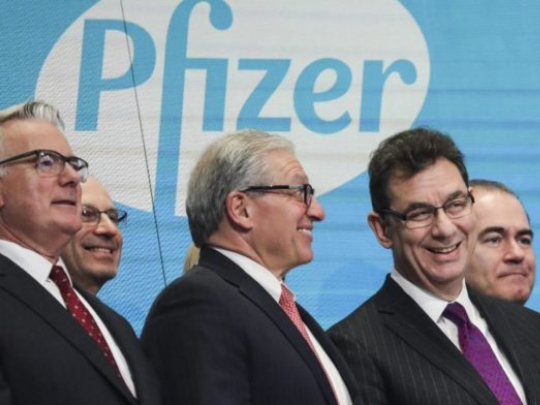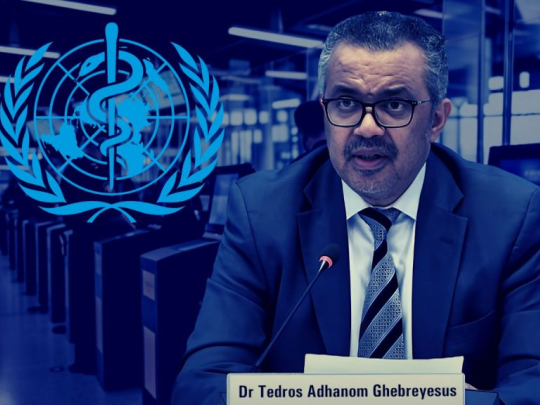How Pfizer Manipulated COVID Vaccine Trial Protocols To Obtain Emergency FDA Authorisation For Children

Analysis and comparison of the review document submitted by Pfizer to the US Food and Drug Administration, on the basis of which the FDA gave the green light to expand the emergency permit for vaccination also for children aged 12-15 (1), as opposed to the study protocol in children (2, 3), reveal concerning findings, including violations of the protocol established by Pfizer itself, and no less serious, designing the trial protocol in a way that will allow the company to present as positive findings as possible in terms of vaccine safety in children.
Violation of protocol conditions – How did children with a psychiatric diagnosis get to be included in the study?
According to the review document submitted by Pfizer to the FDA, four of the 1,131 children in the study arm who received Pfizer-BioNTech COVID-19 Vaccine suffered from serious adverse events (“SAEs”) – that is, events in which at least one criterion was met: caused death, is life-threatening, requires hospitalization or prolongation of existing hospitalization, results in persistent disability/incapacity, or congenital anomaly/birth defect.
Of these four children, three had such severe depression that they were hospitalized shortly after vaccination (in the first 7 days after the first dose, in the second only one day after the second dose, and in the third 15 days after the first dose, respectively).
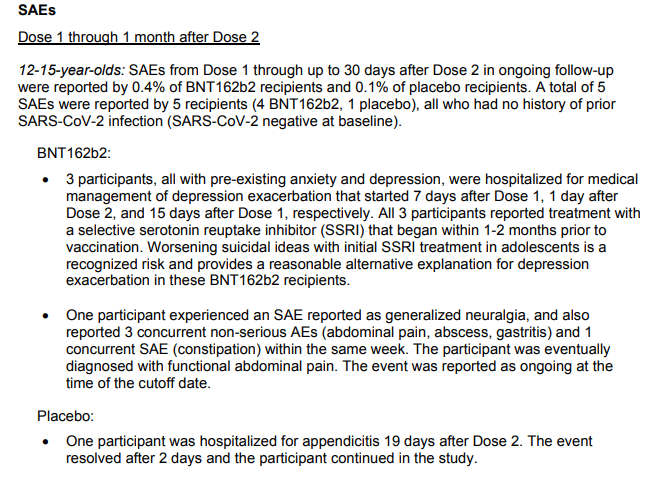
The consequence of this finding is extremely worrying, as it means that one in every 350-400 children who are vaccinated might suffer from severe depression and need hospitalization.
To reassure us, Pfizer notes in its review document that in fact, all three children had a pre-existing diagnosis of anxiety and depression. Moreover, they explain – all three actually reported a selective serotonin reuptake inhibitor (SSRI) that began within 1-2 months prior to vaccination.
“Worsening suicidal ideas with initial SSRI treatment in adolescents”, they explain, “is a recognized risk and provides a reasonable alternative explanation for depression exacerbation in these BNT162b2 recipients”.
So here you go – why blame the vaccine, when there is a perfectly reasonable and logical alternative explanation for the exacerbation of their depression?
What is the problem with this explanation?
Two problems:
- The claim that the SSRIs the children received is an alternative explanation for the deterioration of the children’s mental state is doubtful. According to the scientific literature, exacerbation of suicide and mental state occurs right at the beginning of treatment with antidepressants, usually in the first two weeks, and certainly not more than a month after starting treatment – which is the time when you start to see improvement. In fact, the opposite is true: if there is no improvement within four weeks, a medication is usually replaced.
- More importantly, according to the study protocol – participants with a previous psychiatric diagnosis should never have been included in the study in the first place (see page 41 in the protocol).
It turns out that one of the exclusion criteria in the study is: “Other medical or psychiatric condition including recent (within the past year) or active suicidal ideation/behavior or laboratory abnormality that may increase the risk of study participation or, in the investigator’s judgment, make the participant inappropriate for the study“.

This is therefore a blatant violation of the study protocol established by the company itself and approved by the FDA. The implication of such a violation is severe: if Pfizer were so negligent that they included subjects with a psychiatric background in the experiment – contrary to the protocol they themselves established – it means that the subjects’ well-being is not their main concern. As Pfizer itself notes in the protocol: such a background may increase the risk of study participation. And if they do not adhere to ethics in recruiting subjects, who can assure us that they adhere to ethics in other sections of the study – for example, analysis of results?
Designing the protocol in a way that will allow the company to present positive findings regarding the safety of the vaccine
In at least two criteria, the company appears to have manipulatively designed the protocol in a way that would allow it to present as positive findings as possible in terms of vaccine safety in children:
- Designing the protocol in a way that will reduce, as much as possible, the inclusion of severe adverse events in a report submitted to the FDA.
In the Pediatric Study Protocol (see table on page 12), Pfizer undertook that the duration of follow-up for serious adverse events (SAEs) would be “from Dose 1 to 6 months after the second dose”.
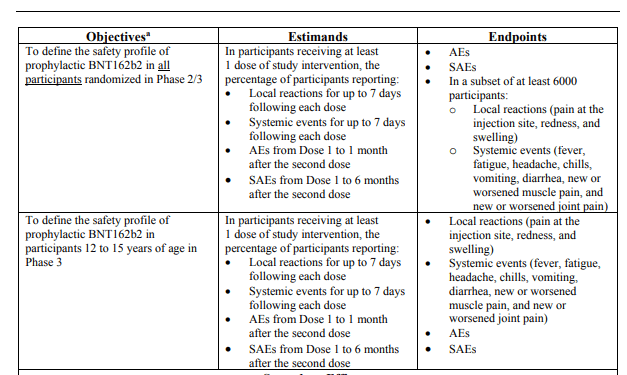
A six-month follow-up period is considered to be very short compared to the usual follow-up time in Phase 3 studies for vaccines. According to the FDA, Phase 3 in vaccine studies should last between one and four years (4).
Yet it turns out from Pfizer’s review document that the company did not complete even this relatively short follow-up period, and in fact was content with only 30 days of follow-up of the severe adverse events. This fact emerges from the chapter dealing with the date of analysis (page 30, under the heading of the SAEs chapter): “12-15-year-olds: SAEs from Dose 1 through up to 30 days after Dose 2 in ongoing follow-up were reported by 0.4% of BNT162b2 recipients and 0.1% of placebo recipients“.

How has this been made possible?
On page 114 of the study protocol – in the chapter dealing with the timing at which the statistical analyzes will be performed, Pfizer set a number of time points for the purpose of performing these analyzes. While the maximum time period for monitoring severe adverse events in the general study population is six months (the seventh section), the fifth section set an additional cut-off point, of only 30 days after the second dose for the purpose of comparing data between two age groups – one of ages 12-15 and one of ages 16-25.

In other words, the protocol appears to be designed in such a way that the review submitted to the FDA will only include the serious adverse events that appeared during the first month after vaccination.
Indeed the follow-up of the serious adverse events continues for another five months, but any adverse event that will be discovered during these months, or an adverse event that was observed during the first month but was defined as non-serious and has been worsening during the following months (or the diagnosis will change) – will simply not appear in the review report.
The concerning implication of this practice is that serious adverse events may not appear in the report on the basis of which the FDA issues the emergency authorization for children, so continued follow-up, even if published a few months or years after the temporary authorization was issued, will not help children who will be harmed or die following the FDA’s green light.
Designing the protocol so that diagnoses of serious adverse events given in hospitals unrelated to the study site can be ignored.
Within the terms of the Outcome Measures in the study protocol, as it is presented in Clinicaltrials.gov Pfizer determined that the research team selected by Pfizer will be the ones defining the adverse events as such: “As elicited by investigative site staff”.
This way, the company has in effect given researchers selected by them the power to define for themselves what the diagnosis will be, regardless of the diagnosis given at the hospital/ward which is not defined as the research site.
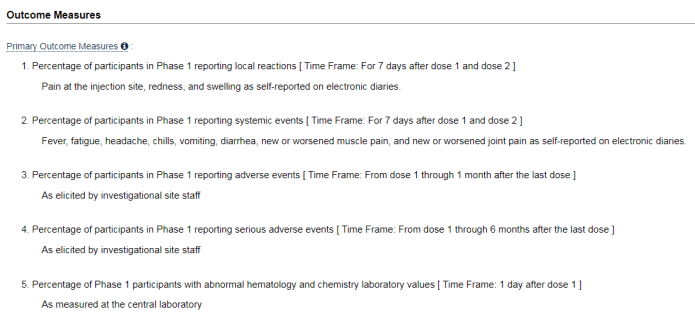
Why is this problematic?
Because such a determination means that if a particular participant suffers from serious adverse events and has been treated, for example, outside the hospital or ward that functions as the research site, then in fact, the diagnosis made by the attending physicians at the hospital/ward in which the participant is treated is irrelevant.
This way, Pfizer has actually allowed its team to define what the diagnosis will be, rather than letting the diagnosis given by the attending physicians confuse them.
Beyond the severe criticism towards Pfizer, the analysis and comparison raise serious questions for the FDA itself:
- How is it possible that the FDA has even approved a protocol that allows such manipulations?
- Why did the FDA allow the company to perform the data analysis and submit the application for the emergency permit in children after such a short follow-up time of only 30 days?
- What made the FDA so eager to approve the emergency permit for children? Why is this approval given based on a safety report that is not even “cooked” half way? After all, there is no emergency situation for children.
- Why did the FDA not address these manipulations and violations of the protocol after the company submitted its review?
Yaffa Shir-Raz, PhD, is a risk-communication researcher and a teaching fellow in the University of Haifa and the Interdisciplinary Center Herzliya in Israel. This article was published on American Frontline Doctors.
References:
- Pfizer-BioNTech. (2021). Emergency Use Authorization (EUA) Amendment for an Unapproved Product Review Memorandum. https://www.fda.gov/media/148542/download
- (2021). A PHASE 1/2/3, PLACEBO-CONTROLLED, RANDOMIZED, OBSERVER-BLIND, DOSE-FINDING STUDY TO EVALUATE THE SAFETY, TOLERABILITY, IMMUNOGENICITY, AND EFFICACY OF SARS-COV-2 RNA VACCINE CANDIDATES AGAINST COVID-19 IN HEALTHY INDIVIDUALShttps://cdn.pfizer.com/pfizercom/2020-11/C4591001_Clinical_Protocol_Nov2020.pdf
- (2021). Study to Describe the Safety, Tolerability, Immunogenicity, and Efficacy of RNA Vaccine Candidates Against COVID-19 in Healthy Individuals. https://clinicaltrials.gov/ct2/show/NCT04368728
- (2018). Step 3: Clinical Researchhttps://www.fda.gov/patients/drug-development-process/step-3-clinical-research
- Source : GreatGameIndia









